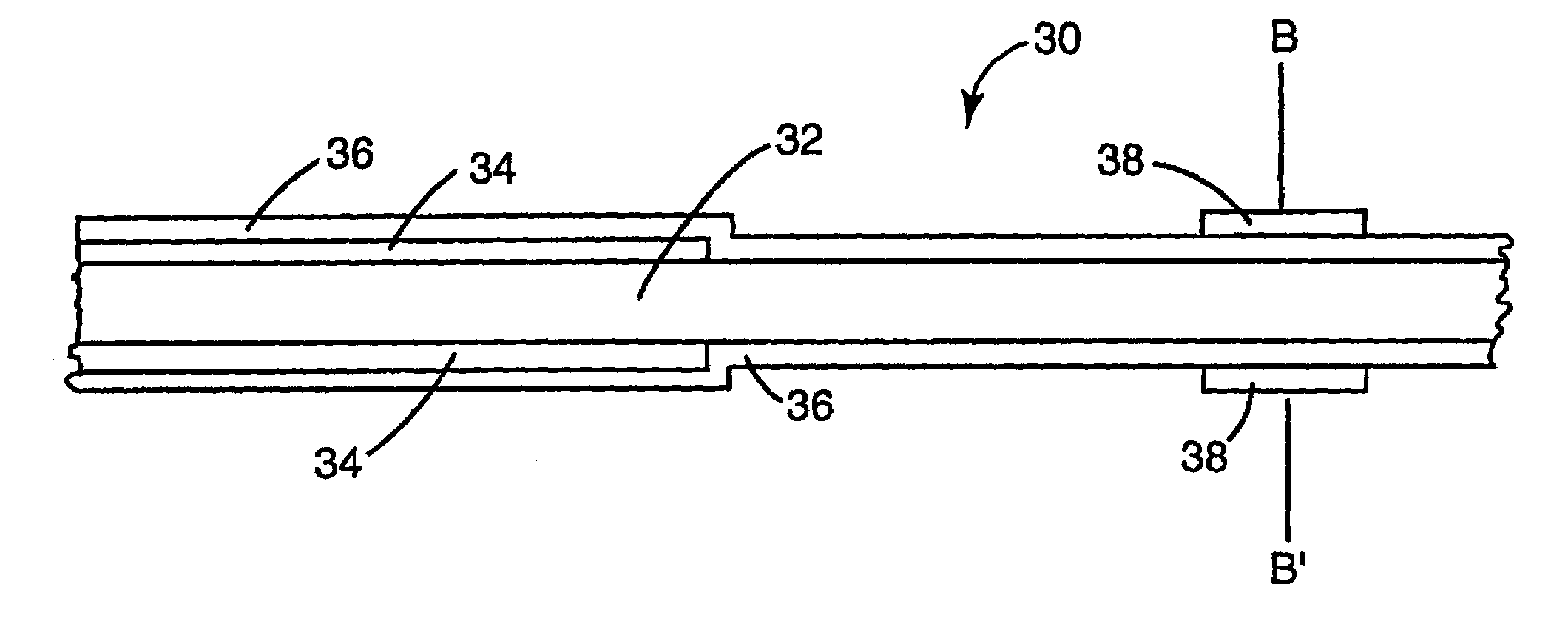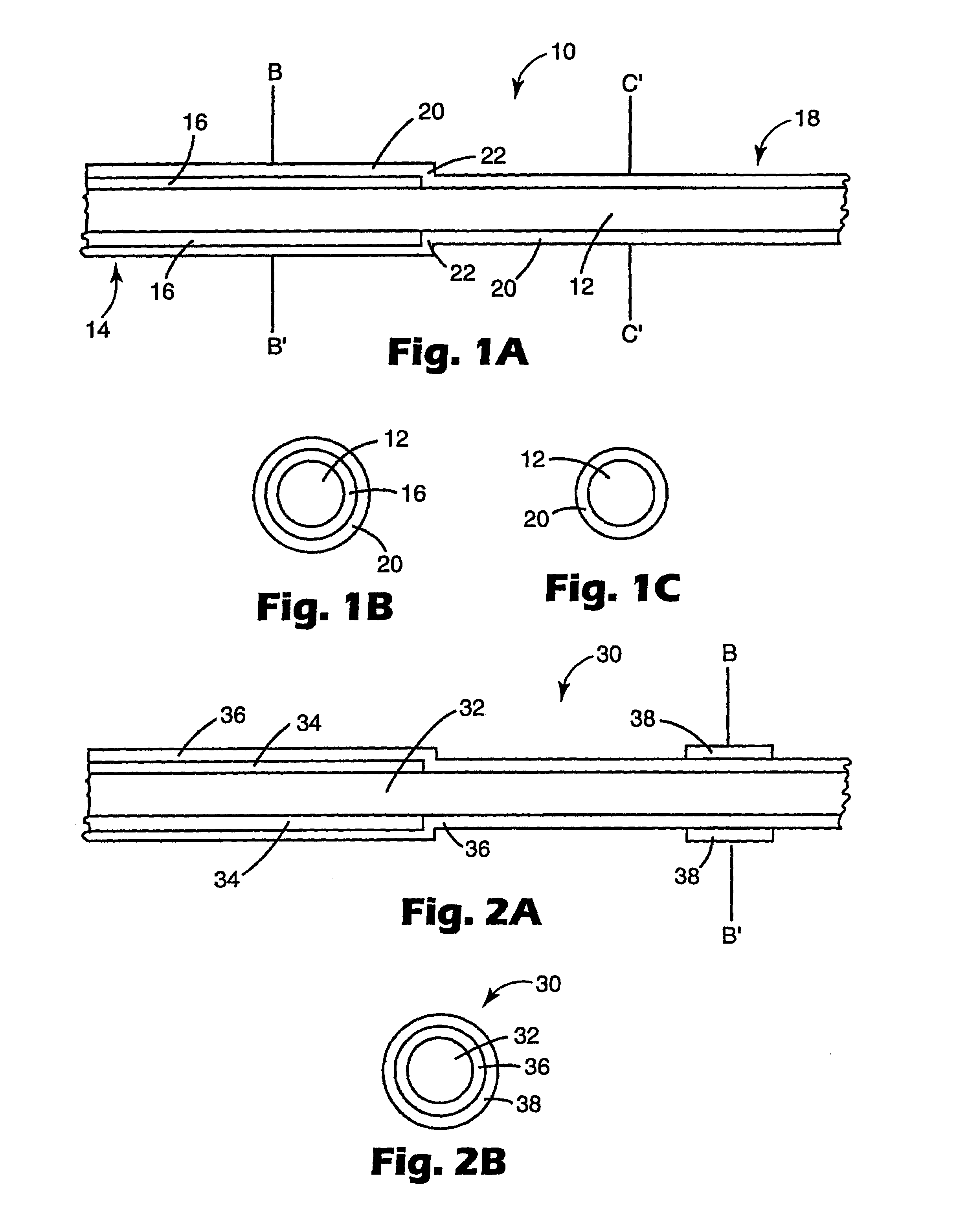Optical and optoelectronic articles
a technology of optical and optoelectronic articles and films, applied in the direction of glass optical fibres, cladded optical fibres, instruments, etc., can solve the problem that glass used in some optical fibers does not readily bond to metals to form fiber optic packages, and achieve the effect of enhancing the high temperature stability of films
- Summary
- Abstract
- Description
- Claims
- Application Information
AI Technical Summary
Benefits of technology
Problems solved by technology
Method used
Image
Examples
example 1
[0090]This example illustrates the effect of DLG thin films as packaging materials for fibers.
[0091]Ten samples were made using acrylate-coated optical fibers (comprising an optical core of Germanium-doped silica with a pure silica cladding, the optical core being the most inner portion of the glass fiber and having a higher refractive index than the pure silica so the total internal reflection can occur to allow the construction to function as an optical fiber), having nominal core diameters of 5 to 10 μm, cladding diameters of 125 μm, and acrylate coating diameters of 250 μm, (the fibers being available as Part No. CS-00-5001 from 3M Company—Optical Components Program, West Haven, Conn.). The fibers were stripped by dipping a 6 cm section of a long length of fiber sequentially into fuming sulfuric acid (at 175° C.) then water. For each sample the section of fiber was submerged in each liquid for about 30 seconds.
[0092]Plasma Reactor One was used to deposit a film on the fibers. Th...
example 2
[0096]This example illustrates that DLG can be made with increased high temperature durability.
[0097]DLG thin films were deposited onto Pyrex glass slides using a pre-cleaning step, a deposition step similar to that of Example 1, and a post-annealing step. Adhesive tape was placed over part of each glass slide surface to provide an uncoated surface area for deposition thickness measurement. Pre-cleaning was done with an oxygen plasma at between 8.6 and 9.3 Pa (65 and 70 mTorr) and 2599 Watts for 2 minutes with an oxygen flowrate of 100 sccm.
[0098]Deposition of a DLG thin film onto the cleaned slides was done in a manner similar to that of Example 1 except Plasma Reactor Two was used and some process conditions were changed. The flowrates of TMS and oxygen were 150 sccm and 100 sccm, respectively. The pressure and power were maintained at 40 Pa (300 mTorr) and 1500 Watts, respectively, and the cleaned glass slide was exposed to the plasma for 10 minutes. The adhesive tape was removed...
example 3
[0101]This example illustrates that a post plasma treatment can be applied.
[0102]DLG thin films were deposited onto partially stripped optical fibers as in Example 1, using Plasma Reactor One. Then the DLG film was treated with oxygen plasma in Plasma Reactor Two. The oxygen plasma was formed with an oxygen flow rate of 500 sccm and an electrode power of 2000 W in a reactor vessel with a pressure of 9.3 Pa (70 mTorr). Treatment was carried out for 75 seconds. The sample was then flipped over and treated for another 75 seconds. The metalization was performed as described in Example 1.
PUM
| Property | Measurement | Unit |
|---|---|---|
| Temperature | aaaaa | aaaaa |
| Thickness | aaaaa | aaaaa |
| Percent by atom | aaaaa | aaaaa |
Abstract
Description
Claims
Application Information
 Login to View More
Login to View More - R&D
- Intellectual Property
- Life Sciences
- Materials
- Tech Scout
- Unparalleled Data Quality
- Higher Quality Content
- 60% Fewer Hallucinations
Browse by: Latest US Patents, China's latest patents, Technical Efficacy Thesaurus, Application Domain, Technology Topic, Popular Technical Reports.
© 2025 PatSnap. All rights reserved.Legal|Privacy policy|Modern Slavery Act Transparency Statement|Sitemap|About US| Contact US: help@patsnap.com



